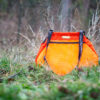Have you ever considered keeping birds for dog training at your house? What if you live in the suburbs or a densely populated area and don’t have acres of land? Once you get far enough into this bird dog world, you start to realize that it’s much easier to have birds on hand than to drive to a bird grower every time you need birds or drive to a training club that has pigeons. The closest bird grower to me is 45 minutes away. I belong to two training clubs: one is 45 minutes away and the other is 1.5 hours away.
I’d never kept quail or chukar at my house long-term until this past summer. Occasionally, after picking birds up from a grower, I would keep them in a crate in my garage for a night or two. When I trained for the NAVHDA Invitational in 2022, I managed without being able to store birds at my house.
We live in suburban Raleigh, North Carolina and own a half-acre of land. It’s not the most desirable place to keep birds, which is part of the reason I never wanted to have my own coop. If I lived in a more rural area and had more space, it would be a little easier. But this past summer, I decided it was going to be a lot more convenient to keep birds at the house than drive around so much. I convinced my husband that I needed to have a coop. He was not thrilled, but reluctantly agreed.
Another reason I hadn’t kept birds before because I was concerned about them not flying well if they were kept too long in a coop that was not large enough. I wasn’t sure I had space for something sufficient in size. Ideally, if you’re going to keep quail or chukar, you have a flight pen that allows them to fly around. But I decided to try it without a large pen.
Procuring a Bird Coop
I thought about building my own coop, but I’m not super handy, so I started looking on Facebook Marketplace instead. I found a few options that were probably equivalent to or cheaper than making my own. I bought a coop that was originally made for housing rabbits. It is enclosed on three sides, has a wire bottom, and is high off the ground. It measures four feet wide by three feet deep and is about two feet tall. My neighbor has a pickup truck, so she came with me to pick it up. I wouldn’t have been able to fit it in my SUV. When I originally bought it, the coop was painted blue. I happened to have some leftover house paint, so I repainted it to match my house. This way it blends in better, too. It’s partially visible from the street since I put it on the side of my house.
This setup works great. The only thing that isn’t ideal about it is the size of the door. I’d rather have a smaller door so it wouldn’t be as easy for birds to get out when I open it. But that’s why I installed the fabric “screen” you can see in the video further down the page. If you build your own coop, you could customize the door size.

The bird coop I’ve used for housing quail and chukar. Clearly I hadn’t cleaned the area underneath in a while!
Check the Laws in Your City/Town
Some towns and cities have rules about keeping pets, including poultry. Make sure you check to see if it’s allowed where you live. If your neighborhood has an HOA, they can be very specific about what is allowed and what is not. Luckily, even though I live in the suburbs, my neighborhood doesn’t have an HOA and the city of Raleigh has no rules about keeping chukar and quail. You are allowed to keep chickens, so I figured game birds were okay.
Housing Considerations
If you’re going to keep birds in a pen that’s fairly small, like mine, you’ll want to figure out what is the maximum number of birds you can safely house for a period of time. Overcrowding is not going to help anything. When I was deciding on how many chukar to keep, I asked a friend who is experienced with keeping birds. Since my coop is 12 square feet, he recommended 12 chukar maximum. For quail, he said I could probably go up to 30, but 20 was the largest number I kept this winter.
It took me a little time to figure out the best kind of food dishes to use. The chukar have been much more aggressive with their food dishes than the quail. They kept knocking over one of the dishes I bought. Eventually I got two metal containers that clip onto the side of the coop so they can’t be moved. I bought these at Tractor Supply.
The waste from the birds falls through the wire mesh onto several large stones that are positioned under the coop. This allows me to easily scrape off the droppings. Since my house is fairly close to my neighbors, I try to clean the poop about once a week. It does smell some, especially when it’s hot out or has rained, but I don’t think it’s too bad. No one has complained yet!
Watch Out For Predators
One of the biggest issues when keeping your own birds can be the threat of predators: hawks, coyotes, raccoons, opossums, cats, snakes, etc.
Thankfully, I have not had any issues with predators even though I have seen all of the above in my neighborhood. I think the fact that the coop is elevated helps a lot. I also have a motion-control light on the front that comes on at night. I imagine that might scare off a potential predator. If you are keeping homing pigeons that you let out to fly, I think there’s a much greater risk for predators (especially hawks) to get them.
Dealing With Escapees
When I first got my coop, I was keeping chukar since I was training for the Invitational and chukar are used for field work. I had one escape when I opened the door, but it was fairly easy to catch. It walked along the front of my house into some tall plants and I managed to capture it with a net.
This fall, I switched to keeping quail, since that is the bird of choice for field trials around here. I also had a quail get out, but they are much more difficult to catch. They run fast and are more likely to fly off when you get close. The unfortunate thing about quail is that they like to stay close to other quail. Every night, the quail would spend the night underneath my coop, near its friends. It had plenty of food to eat, since excess food would fall through the wire mesh onto the ground underneath the coop. And when I would come outside, it would often run into my fenced backyard, where Zara was waiting. Next thing I knew, my supposedly broke dog was stalking and chasing the quail. Needless to say, I was not happy.
I was surprised how long the lone quail survived outside of the coop! It was below freezing at night and I was shocked that it didn’t freeze or get eaten by a cat or coyote. I was getting frustrated trying to catch it and I didn’t want Zara to develop bad habits by having access to it when I wasn’t watching. Eventually, I set a spare bird box underneath the coop and put some leaves and a food dish in there. One day when I came by, the rogue quail was in the bird box and I managed to close the lid before it could escape again.
This would be less of an issue if you had a large property and your coop was further away from where your dogs have access to. While my coop is outside of my fenced backyard, it’s only a few feet from the fence. So my dogs had much easier access to the quail when it got out.
One of my friends was keeping chukar in her backyard and one got out. Later that day, a photo of the chukar showed up on her local NextDoor page, with someone wondering if a pet bird had escaped. I don’t think she responded to the post. Ah, the joys of living the suburbs!
Mixing Birds
One thing I’ve heard people say is to be cautious about adding new birds once you have an “established” group. New birds can bring disease to your existing ones, or there could be a fight. I haven’t attempted to mix birds. I’ve always gotten a bunch of birds, used them all for training, and then replenished my supply once the coop was completely empty. I did have an issue when there were only two chukar left in my pen. Apparently that was not a good number, because one of them killed the other. :( I’m not sure if they were both males, or what the issue was. They had been fine together when the group was larger (five or more) but not when it was just the two of them.
The Birds Performed Well
With both the chukar and quail I kept, I was surprised at how well they flew even after I had kept them for a few weeks. While I did want them to fly, given where Zara and I are in training, I was also okay if a few of them just hopped or ran. She should be able to handle anything at this point. I think the longer you keep them, the less likely they are to fly well, so I tried not to house them for too long.
Overall, it’s been great having a coop at my house, even though it’s fairly small. I think my next adventure will be building a pigeon coop and keeping homing pigeons. That project is probably at least another year away though. I need to convince my husband first…
Have you kept birds in a suburban environment? Leave me comment below.







